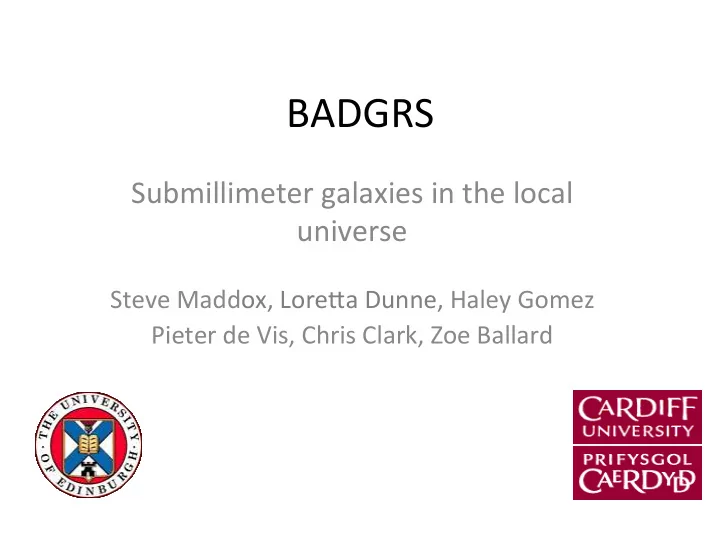

BADGRS Submillimeter galaxies in the local universe Steve Maddox, Lore=a Dunne, Haley Gomez Pieter de Vis, Chris Clark, Zoe Ballard
Sub-mm selecGon of local galaxies de Vis et al 2017 • dust fracGon increases rapidly as stars form • then declines as star-formaGon stops • different selecGons favour different stages
HAPLESS and BADGRS • Local volume-limited sample from phase 1 H-ATLAS, 15<D<46Mpc • found >50% of galaxies were: – very blue (FUV-K)<3.5 – intermediate mass (10 8 < M * < 10 10 M ¤ ) – flocculent or irregular morphologies – high gas fracGons in terms of HI. • Blue And Dusty Gas Rich Sources – BADGRS • only 6% of stellar mass, 30% of dust mass density 20% of the star formaGon rate Clark et al 2015
Dust Temperatures and RadiaGon field Diffuse dust temperature in the BADGRS is 13–14 K (cf 18–31 K for normal • spirals) For the same dust properGes, this would require an ISRF 10–20 Gmes lower • than the local GalacGc value. The measured radiaGon surface densiGes are similar to local GalacGc value • Need either • – different dust geometry (clumpier) – different dust properGes (size distribuGon, composiGon, opacity)
Sample of 4 BADGRS for detailed follow-up • Range of gas fracGons • Higher dust mass per stellar mass • Very blue: FUV-K < 2.7 • Follow-up observaGons – CO lines (IRAM + APEX) – HI maps (VLA + GMRT) – opGcal IFU spectra (AAT) – CO maps (ALMA)
4 BADGRS • yellow – IRAM CO poinGngs • green – KOALA IFU and ALMA coverage
CO in BADGRS
CO in BADGRS • Low CO flux ( Peak T MB ~ 5 – 30 mK ) • Narrow Line widths ( FWHM 30 – 100 km/s ) • Wide range of excitaGons ( r 31 = 0.25 – 0.6 )
A lack of molecular gas? • Deficient in CO emission cf 250 flux by factor 2 to 7 (average 4.2) • M H2 /M dust ~10 Gmes lower than seen in local spirals ( M H2 / M dust ~10 vs ~100 ) Grossi et al 2016
A lack of molecular gas? • Deficient in CO emission cf 250 flux by factor 2 to 7 (average 4.2) • M H2 /M dust ~10 Gmes lower than seen in local spirals ( M H2 / M dust ~10 vs ~100 ) Grossi et al 2016
Reasons CO may be low • ISM condiGons unfavourable for HI è H 2 conversion, so very li=le molecular gas. • Low metallicity, so CO is destroyed. • Is either possibility correct?
Low Molecular gas • If most gas is HI, then dust would trace HI • Compare HI to dust distribuGon • HI peaks don’t trace dust • The deficiency in CO does not appear to be due to a lack of H 2 • Also esGmates of the ISM pressure suggest that >50%of the gas should be molecular
Metallicity • Low metallicity can lead to low CO: – low Z è low dust è reduces the shielding of CO in molecular clouds – CO is strongly photo-dissociated at Z < 0.5 Z ¤ • But measured metalliciGes are not low ( O/H abundance ~8.4 ) • And we can see plenty of dust
Paradoxical properGes • Very dusty, but very blue • Low temperature dust, but strong ISRF • Low CO but metal rich • to make progress need – high resoluGon CO and dust measurements from ALMA – opGcal IFU data to measure gas surface densiGes, kinemaGcs, line raGos, metalliciGes, star formaGon histories, and dust a=enuaGon – resolved SED finng (including radiaGve transfer modelling)
IFU Koala ObservaGons • opGcal spectra – blue 3600A to 5700 with 1A resoluGon – red 6100A to 7300A with 0.6 A resoluGon • O[I], O[II], O[III], N[II], S[II], H α , H β , H γ , H δ
Koala IFU ObservaGons • Analysis of line strengths from spectral cubes underway • Measure kinemaGcs of both gas and stars – rotaGon – velocity dispersion – Toomre Q value • SpaGally resolved measurements of: – dust reddening – O and N abundances – excitaGon temperatures
Summary • Dust selecGon favours high gas fracGon galaxies • About half are very blue, flocculent, intermediate mass galaxies • BADGRS – contain only 6% of stellar mass, but have 30% of dust mass density and 20% of the star formaGon rate • Unusual ISM properGes: – low T dust but high IS radiaGon field – should be H 2 rich but are found to be CO poor • In order to explain this discrepancy there must be either: – a radically different dust geometry (clumpier) – different dust properGes (size distribuGon, composiGon, opacity) compared to the Milky Way and other local galaxies
Recommend
More recommend